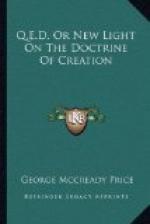Mendel worked chiefly with peas, crossing different varieties. In his methods of investigation he differed from all previous investigators in concentrating his attention upon a single pair of alternative or contrasted characters at a time, and observing how these alternative characters are transmitted.
Thus when he crossed a tall with a dwarf, giving attention to this pair of contrasted characters alone, he found that all the first hybrid generation were talls, with no dwarfs and no intermediates. Accordingly he called the tall character dominant, and the dwarf character recessive, and a pair of contrasted characters which act in this way are now called factors or sometimes called unit characters. But on allowing these hybrids to cross-fertilize one another in the usual way, Mendel found that in the second generation of hybrids there were always three talls to one dwarf out of every four. Further experiments proved that these dwarfs of the second hybrid generation always bred true, that is, one out of four; and that one out of the remaining talls always bred true, making another quarter of the total; while the remaining fifty per cent. proved to be mixed tails, always acting as did the original hybrids, splitting up in the next generation in the same arithmetical proportion as before.
Accordingly, if we confine our study to the two contrasted characters, tallness and dwarfness, we see that just three kinds of peas exist, namely, dwarfs which breed true, talls which breed true, and talls which always give the same definite proportion of talls and dwarfs among their descendants. Innumerable experiments which have since been made with other pairs of characters have demonstrated that this same mathematical proportion holds good throughout the whole world of plants and animals;[25] and hence this astonishing result is now called Mendel’s Law, and is regarded as the most important discovery in biology in several generations.
[Footnote 25: When dealing with only a few individual cases, we do not always find them to come out in such exact proportion; but when the number of examples is large, the proportion is so close to these figures that the exceptions can be entirely neglected as probably due to error of some kind.]




